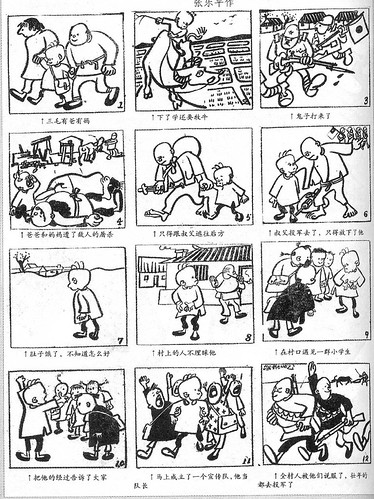One of the nice thing about studying modern Chinese history is that Chinese states have gone to gone to great lengths to collect oral histories and other accounts of events. The Communists were particularly good at this. The point of a lot of this is to make the revolutionary experience available to later generations. It was the events they witnessed and the suffering they felt that made people revolutionaries, and this radicalizing experience had to be packaged and distributed to new people. Thus the Communists were big on things like re-creating the Long March and re-creating the old battle against class enemies by flinging professors out windows (a topic my students always find interesting.) All of this began in the Republican period, of course. Here is a wartime cartoon by張乐平1

In the top row of panels we see our hero Sanmao2 as a farm boy, but then the Japanese show up and kill his parents. In the second row his uncle takes him to the rear area, but then the uncle leaves him to go join the army. In the third row he is hungry, but the people (actually, the adults) of the village ignore him. He meets some children however, and tells them of his experiences. They promptly form a propaganda team with him as the leader, and they convince people from the village to go join the army. These propaganda teams were a big deal for the Nationalists and the Communists, but all of them were supposed to have the same feedback loop as this cartoon. Sanmao has an experience that raises his (and his uncle’s) consciousness. The uncle acts, but Sanmao drifts until he is asked about his experiences. Panel nine (second from bottom right) shows him shyly telling his story. By panel ten his is getting more wound up as he realizes the possible value of telling about his suffering in arousing others. In panel eleven he gets his personal reward, as he becomes an important figure in the group, and in the final panel the nation gets its reward in the form of two soldiers.